Emiko Davies's Blog, page 12
August 5, 2017
Ten ways to survive an Italian heatwave
Newstands this morning declared the centre of Florence “feels like” 50 degrees Celsius (122 Fahrenheit) and signs warned of extreme heat this week, to stay indoors and avoid outdoor activity. They say this is the last (the fifth) heatwave of the summer. Here’s how to deal with it.
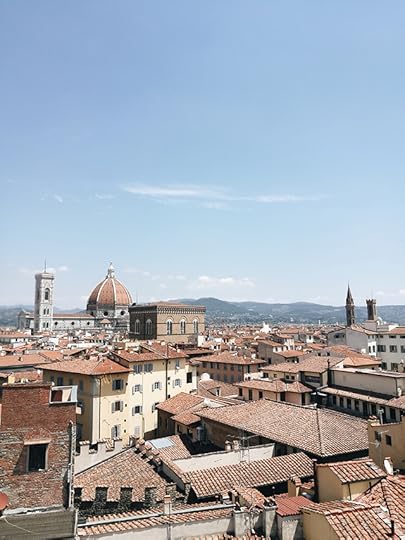
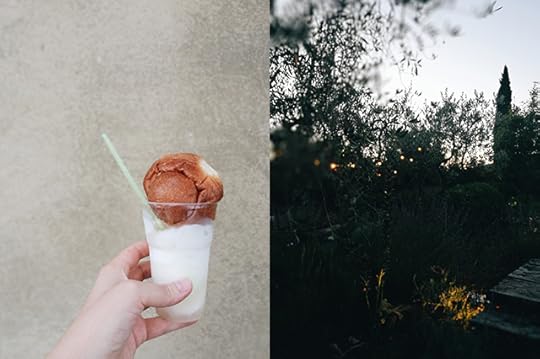
Under the Tuscan Sun may embody a dream for many, but Tuscan summers have always felt like an inferno to me, easily my least favourite part about living in Tuscany. And it’s not because I’m not used to the heat — in Australia, on average, the summers are hotter. But somehow they just never feels as long and as unbearable as a Tuscan summer (apparently it’s not just the urban heat island created in most cities in the summer, talked about in this Smithsonian article). No doubt the stone cities, built on medieval plans with rarely a tree in sight, with their red-brick rooftops that heat up like a pizza stone in an oven have a lot to do with it, along with Florence’s relatively small size and the fact that it sits in a bowl, surrounded by hills. There’s also a lack of that everyday summer comfort, air-conditioning (why? Getting “hit by air” is a serious illness in Italy). But there are ways to deal with a heatwave in Italy and the best way to do it is how Italians have alway done it.
Here are my top ten ways to survive an Italian heatwave:
1. Close your windows and shutters. Those heavy wooden or metal shutters on the outsides of windows serve to keep the sun and heat out. Keep them closed during the day. Do not open the windows in an attempt to get a breeze until the sun is well and truly down. If the sun is streaming into the room, keep the shutters closed too. Then, open all the windows at night, your best bet at cooling the place down, as temperatures are at at their lowest in the wee hours of the night, just before the sun rises. If mosquitoes are bothering you, try anti-mosquito plugs, available in supermarkets and hardware shops.
2. Siesta. That break in the middle of the day when smaller shops close between 12:30 and 3:30 (or in some places, you’ll find it’s a ghost town until 5pm) is the best time of the day to be home, or somewhere cool, eating a slow, leisurely lunch and resting in the hottest part of the day. Don’t try to venture out, or climb the steps to the top of the Duomo at this time. Take a rest.

3. Granita for breakfast. In Sicily, where temperatures soar in the summer, the morning brioche is eaten together with a granita, an icy, slushy, refreshing mixture between a drink and a sorbet — lemon granita, almond granita, watermelon, elderflower or coffee are just a few of my favourites. In Florence, try them at Gelateria Carabè . Similarly, I think once you’ve had granita for breakfast, all the rules about when one should eat gelato go out the window. Gelato is a meal in the summer.
4. Caffe con ghiaccio. Forget hot drinks. Ask for a caffe con ghiaccio, iced coffee — in Puglia, more specifically Lecce, it’s a Caffe Leccese and is a shot of coffee, over ice with almond milk. In Tuscany, it’s more common to find caffe shakerato — espresso shaken with ice until frothy and chilled — or at home, to make an affogato, coffee drowned in gelato.
5. Keep the oven off. Avoid cooking. Summer produce is meant to be eaten fresh — think prosciutto and melone (cantaloupe or rockmelon) and summery, tomato-filled salads like caprese and panzanella. If you need something more substantial or more protein, try a bean, tomato and red onion salad (which you can find here). Or go out for pizza. Florentines in the know head to La Capponcina in Settignano, in the hills, where you can have pizza al fresco on a large terrace overlooking the woods and the twinkling lights of Florence below.
6. Stay al fresco at night. I love seeing towns come alive at night once the sun goes down. People bring chairs down from their hot apartments and sit on the pavement to try to catch a breeze and the entire street can become a social event where everyone sits outside and chats until the wee hours of the night — it’s better than television and at least you keep cool. There are also lots of outdoor summer events where you can eat or go for a drink along the Arno river, where it is slightly cooler than the hot piazzas in town (you can find event listings in English at The Florentine and Firenze Spettacolo). There’s always the passeggiata, a long walk in the late evening, often with dogs or a baby in a pram — and remember that the gelaterie are often open until midnight.
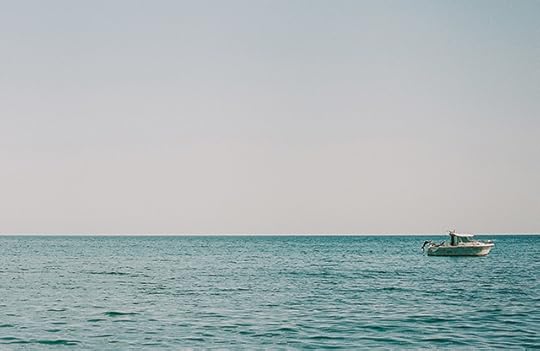

7. Head to the mountains or the sea. Of course, everyone else will have this same idea so if you can avoid traveling on weekends, when you’ll find yourself stuck in traffic during the exodus, it’s a great plan. Head to the Tuscan coast, grab a ferry to an island, go the mountains and dip your feet in a cold river or lake or escape at least to the countryside where, outside of the stone walls of the city you’ll find more of a breeze at least in the evening.
8. Head to a church. Call it natural air-conditioning, but the large, ominous and dark structures of medieval or Renaissance churches provide the cool relief of a cave in the summertime. In Florence, I particularly like the Church of Santa Trinità for its beautiful frescoes in the Sassetti chapel depicting the street of Via Tornabuoni in the Renaissance and the Brancacci chapel in the church of Santa Maria del Carmine. Take it slow, find a bench to sit on and relax. Santa Maria Novella is also wonderful (for Masaccio’s Trinity and the Tournabuoni chapel frescoes especially), as is the quiet, under-visited cloister to the lefthand side of the church facade.
9. Drink plenty of water. In Tuscany, you can refill your plastic bottles with chilled drinking water (both still and sparkling) at any of the Publiacqua fountains. Most are in residential areas, but the more convenient ones to the historical centre are in Piazza Signoria, n.23 (yes, believe it or not, encased in a wall of Palazzo Vecchio), on a corner of the Porcellino Market facing Via della Seta, Via dell’Agnolo, n.4, (near corner of Via Buonarroti, between Casa Buonarroti and Piazza dei Ciompi in the Santa Croce area) and Piazza Tasso, n. 55 (in Oltrarno area and conveniently across from a very good gelateria, La Sorbettiera, too).
10. Avoid August. This is the time when most Italians take their annual summer holiday, especially around Ferragosto, 15 August, and it means that many cities shut down — restaurants and shops may close even the entire month — while seaside towns fill up with Italian holidaymakers. Florence remains pretty functional during August but many of my favourite restaurants do close for most of the month. If you can, try to plan your trips around this time — or maybe head to a place in the countryside with a pool.
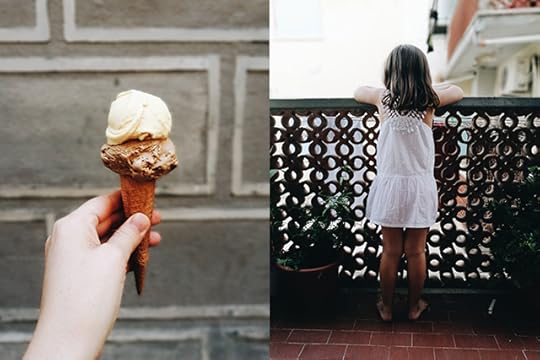
Have any other good solutions for managing an Italian heatwave? Let me know in the comments!
Photos from top to bottom and left to right: Florence from the rooftop of Hotel Torre Guelfa; granita al limone with a brioche; the enchanting garden of Canto del Maggio after sunset; taking a nap; summer tomatoes; diving off a boat in Porto Ercole (this is also available as a print); me in scorching hot Rome, taken by Lauren Bamford for One Fine Stay; an evening walk in my neighbourhood, Settignano; gelato from Grom and trying to catch a breeze on the terrace.
July 31, 2017
In Venice with Valeria Necchio, author of ‘Veneto’

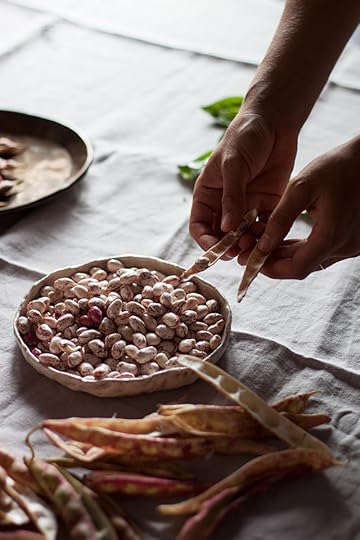

“This is a food memory for me,” Valeria said, as we podded fresh, marbled-pink, borlotti beans, “Not exactly cooking but they were one of the first activities I was involved in as a young girl helping in the kitchen during the summer months: I was on podding duty.”
If you are a long time reader of this blog, then Valeria needs no introduction — we became friends, first via our blogs, years ago when we began writing monthly themed posts together for Italian Table Talk, and then not long after, in person. I have always admired Valeria’s writing, her knowledge and appreciation for food and traditions, and her careful, beautiful photography. I have found her to be a kindred spirit, from the beginning all the way through writing our first cookbooks together, and since she is also a world traveller, living in London, Sydney and now back in Italy, it has been a while since we have been in the same country together.
We sat around the table with a kilo of these mottled beans that we had picked up at the Rialto market, admiring their designs as if they were little works of art and often stopping — as food bloggers do — to photograph them in a pretty dish handmade by Zaira, who was topping the green beans. They were to be cooked for dinner — the borlotti beans for a salad with huge, blushing ox heart tomatoes and red onion, and the green beans tossed with garlic, both recipes from Veneto.

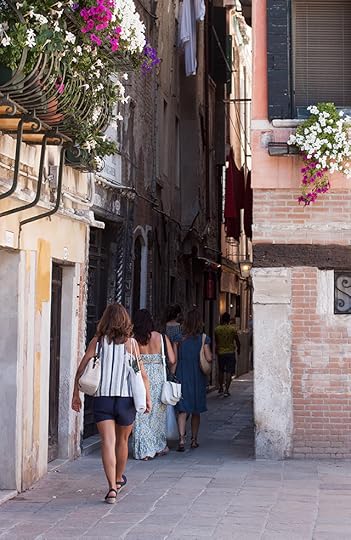

It was one of the reasons we — Irene, Valentina, Zaira and I — were here, to see Venice through Valeria’s eyes, to cook together from her new cookbook, Veneto, an ode to her homeland, and to clink many glasses of prosecco together.
Veneto celebrates an unsung part of Italy’s vast food culture with a peek into generations-old family recipes and the right combination of old favourites and new flavours, all documented beautifully in (Valeria’s own) photographs and words that take you right beside the writer to the Venetian countryside.
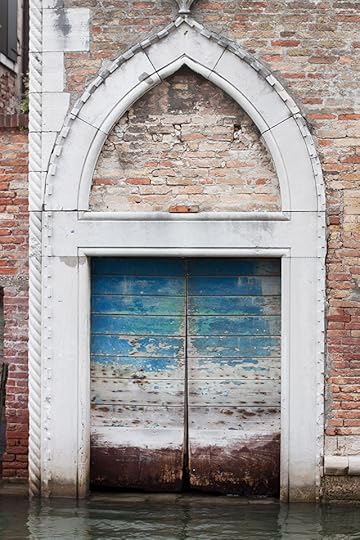
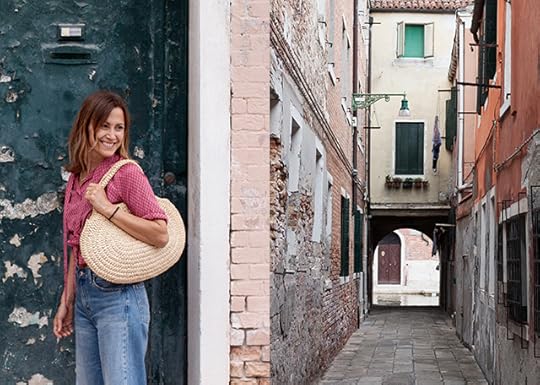
We were lucky enough to actually have the writer with us, right there, in Venice.
We wandered the calle of Venice for hours, to the sound of water lapping at the edges of the canals, and visited the markets as well as some bookshops and beloved cichetti bars to eat morsels of baccalà mantecato, boiled eggs with anchovies and sarde in saor (many which I have already written about here, here and here) — and then we collapsed on our couch in our apartment in Campo Santa Margherita and devoured Valeria’s Zaeti (my favourite Venetian biscuits, made with polenta flour and raisins) with strong coffee.
Valeria also introduced us to a favourite restaurant of hers, Anice Stellato, in a gloriously quiet corner of Cannareggio, where we sat by the water and had a wonderful modern Venetian meal of seared scallops with candied lemon and spaghetti alla busara with scampi washed down with a carafe of cloudy prosecco — one of the highlights of our Venetian escape.
What a pleasure and honour it was to be amongst this group of talented, creative Italian women, celebrating a book of new and old traditions of this region.
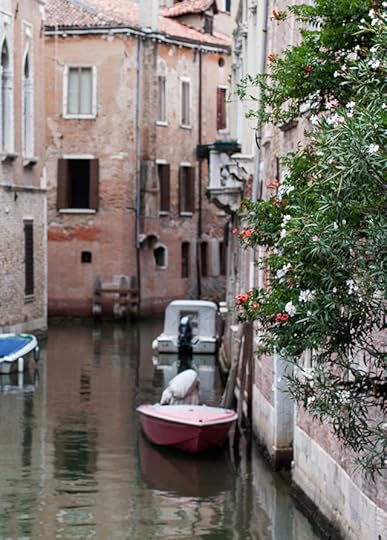
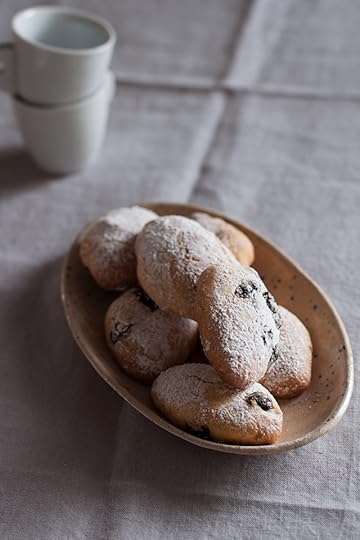
Venice with Valeria Necchio for Veneto, her debut cookbook from Emiko Davies on Vimeo.
July 25, 2017
Eggs and anchovies

My first memory of cooking was with my grandmother, Rosemary, in Sydney. She taught me how to make scrambled eggs on her electric stovetop, the kind with the coiled heating elements, in her small, linoleum-lined kitchen with cupboards that stuck a little when they closed. She was not an exceptional cook — I can remember plenty of bland and overcooked vegetables and custard made with powder to pour into pre-bought pie cases with tinned pineapple, her specialty — but she worked hard to put a balanced, home-cooked meal on the table three times a day, every day.
The eldest of eight children, she dropped out of school during the Depression to help her single mother look after her siblings and work as a seamstress at David Jones. When the Second World War broke out and she was engaged to my grandfather, Aubrey, she started working on war-torn planes (“sometimes looking as if a steam roller has gone over them,” she said) as a sheet metal worker, putting them back together, when many of the men who used to do this work were off fighting the war. She said it was just like dressmaking, only using different materials.
She had a twinkle in her eye and a distinct laugh that can really only be described as a cackle. She was a strong, incredibly smart woman with a fighter spirit who led her female co-workers out on the airport tarmac one day on a strike to earn equal wages to men. I am so proud that her story is taught as part of the Australian primary school curriculum.

Her dream was to have a home with that electric stove. In 1943 when she was 28 she was interviewed for Australian Women’s Weekly magazine for an article on women in men’s jobs during the war, where there is a photo of her that is etched in my memory, dressed in white, wearing a white bandana tied in a knot at the top of her dark curls, a plane behind her.
“It is heavier work than most of us were used to, but we like it because it is interesting and we know it’s important. I am putting money into war savings certificates, as all the other girls are,” she explains. “We are planning a home when the war is over, and I want mine to be all electric — including stove and refrigerator. These are things very few of us working girls can afford in normal times when we marry, so if I can save enough for them my war job will have been doubly worthwhile.”
In my first ever cooking lesson that I can remember, Rosemary — Nanna Rose, we called her – showed me how to make scrambled eggs in a small saucepan on that electric stove that she saved up for working on war planes. We cracked and egg into a small bowl and beat it with a fork with a splash of milk and a pinch of salt. Then into the pan went a good knob of butter — my grandmother was very, very fond of real butter, which she would smother onto her toast with Vegemite every morning – and when it began melting, over a slow heat, the egg went in. With a spoon, she showed me how to mix in the melted butter and gather the egg as it cooked around the edges, stirring slowly, waiting a bit, stirring again, until the thick, creamy flecks of egg began to take shape but are still glistening and soft. “You have to take it off now, just before it’s finished cooking, because it will keep cooking once you put it on the plate,” she instructed.
She may have overcooked her broccoli and brussel sprouts but I have always preferred this way of making soft, creamy scrambled eggs, exactly as she showed me, with real butter and plenty of it, and carefully cooking them slowly.
This recipe is almost a non-recipe, an idea, that is not mine. I had a delicious meal at Rawduck in London last year during my book tour for Florentine. I could eat everything on the menu there, but the scrambled eggs with anchovy was something that lingered in my mind for a long while after that. I tucked it away in a compartment, saving it for a day when I don’t have anything in the fridge or no desire to stand in front of a hot stove for long — or just want something that I know I will absolutely love every morsel of. Today, it is just what I need.
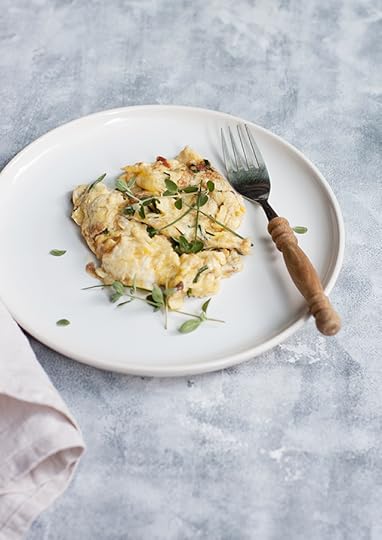
Scrambled eggs with anchovies — Uova strapazzate e acciughe
Fabio Picchi, Florence’s famous chef of Teatro del Sale and Cibreo, suggests to do this too, but with a fried egg, over the top of the sauce of melted butter and anchovies. Salted anchovies are my preference — they are preserved under salt rather than oil, but if you only have the ones under oil that is fine too. Salted anchovies need to be split into their two fillets to pull out the spines. Soak and rinse them well under water to remove the excess salt, then pat dry before using.
For one person:
A large knob of butter
2 anchovy fillets
a few fresh herbs — parsley, chives, oregano, for example
2 eggs, beaten in a small bowl
In a small saucepan or frying pan, melt the butter over low heat. As soon as it is melted and still pale, add the anchovy fillets and herbs and let them melt down into a glorious sauce. Tip the eggs in and swirl them through the buttery anchovy sauce slowly, letting the eggs rest only for a moment to cook before moving them again. When they are still glistening and a bit wobbly, not entirely opaque but almost, take them off the heat and place on a plate. No need for salt here, but pepper is nice. Serve immediately with some crusty bread.
July 5, 2017
Crostata di Susine Selvatiche (Wild Plum Tart)

This is not a very practical recipe unless you chance upon a basket of wild plums at your local farmgate, like I did, while picking out some enormous, gnarled tomatoes, sunny zucchini flowers and purple and white eggplants the size of my fist. Or, even better, find yourself a wild plum tree that no one else (birds and bugs included) has noticed. In years of scouring farmers markets, I have never once come across wild plums, even though they are well-used in the Tuscan countryside (presumably in some lucky people’s gardens or properties) — when I was researching recipes for Acquacotta I was told homemade wild plum jam was a traditional ingredient in recipes like Monte Argentario‘s pagnotella, a christmassy cake that is somewhere between a fruit cake and a brownie.
So perhaps you can file away this recipe “just in case” you come across wild plums because I can positively say, their unique, lip-smackingly tart flavour is what makes this tart so very special. You can of course use any other plum — blood plums or, one of my favourites, greengages – for a classic crostata.


These particular wild plums are also known as susine ciliegie, or “cherry plums” because, well, they are small, deep red and look a lot like large cherries. I spotted them at the little farm that sits at the bottom of Settignano, La Talea, an incredibly rustic and picturesque spot that sells their organic fruit and vegetables, as well as their ancient grains (in whole, ground or pasta form) — and I jumped on them. I still marvel at the fact that this farm is only 10 minutes drive from historic, bustling Florence.
There are only so many things you can do with wild plums, which are nearly as sour as lemons and the easiest way to transform them is into a ruby-toned jam. I could have left it at that, but to be honest, although I adore making jam, I rarely eat it — so it became a classic crostata, with my favourite trusty dough from Pellegrino Artusi’s 1891 cookbook, which I made with ground farro (spelt) flour from the farm. The spelt gives it a bit more character which I think is really fitting with the rustic origins and sweet and sour of the wild plums.

Crostata di susine selvatiche
Wild plum tart
This is essentially my favourite jam tart, a riff on an Artusi recipe for the shortcrust pastry, which was always Marco’s nonna’s go-to pastry recipe as well. I prefer this a thousand times with homemade jam (like this apricot jam) or fruit that has been cooked down to a somewhat jammy consistency (like in these little cherry tarts) over store-bought jam, but it’s a fine recipe to use with a good store-bought one too if you need something like this in a pinch (you will need about 250 grams of jam).
For the jam:
700 gr of fresh wild plums (or other plums, or sour cherries)
400 gr of sugar (I used a mixture of half raw sugar, half white sugar)
For the farro flour pastry:
250 gr farro flour
125 gr cold butter
70 gr sugar
1 egg plus 1 egg yolk (save the white for brushing on top of the pastry for a shiny crust)
For the jam:
Place the plums in a saucepan with some water — about 60 ml (1/4 cup) will do. Heat gently and let simmer until the fruit cooks down, about 10-15 minutes. Remove from the heat and pass the fruit through a food mill/mouli/passatutto to remove the skins and pits — alternatively you can do this by pushing the fruit through a sieve. You’ll end up with a bowl full of juice and smooth pulp.
Place the pulp and juice back into the saucepan and add the raw and white sugar. Bring to a boil and let boil rapidly — keep an eye on it — giving a stir occasionally until the foam subsides and it looks glossy. I like the freezer test — a blob on a cold saucer that has been sitting in the freezer can easily tell you when it’s ready. It should slide slowly and a poke will show wrinkles in the surface. I like this as a softer jam. Remove from the heat and let cool.
For the pastry:
Chop the cold butter into small pieces and add to the flour and sugar. Pulse or (if using hands) rub the butter into the flour until you get a crumbly mixture and there are no more visible pieces of butter. Mix in the beaten egg and the yolk until the pastry comes together into a smooth, elastic ball. Let rest in the fridge for at least 30 minutes. You can even do this the day before and keep in the fridge — in fact, on a hot day, this is a really good idea as the dough will be very chilled and easier to work with.
After resting, cut about a third of the dough off and set aside. Roll the rest of the dough out to about 3mm thickness and cover a 23cm pie dish, trimming the edges. Fill the pie with the jam (no more than about 1cm high) and roll out the rest of the dough into long ‘snakes’ then criss-cross these over the top, sealing the edges together by gently pressing. If you like, use the leftover egg white to brush gently over the top of the pastry. Bake at 180ºC for about 25 minutes or until it is golden.
June 26, 2017
The Perfect Tuscan Coast Getaway 2017
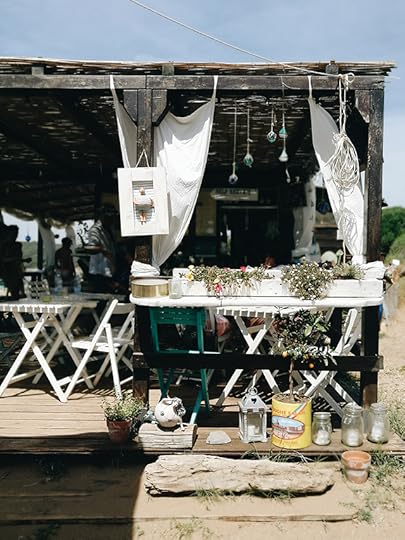
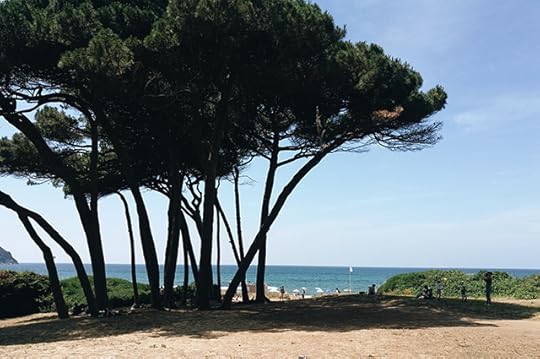
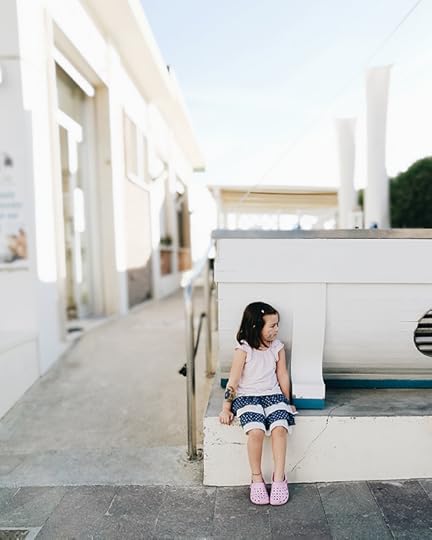
I’ve been coming to the Etruscan Coast — the stretch of Tuscan coastline from Livorno to Piombino and all the islands in between — ever since I met Marco, over ten years ago. His grandparents, like so many Tuscans, have had an apartment here since the early 60s, so it was their stomping ground; their childrens’ and their children’s children spot for their annual summer holiday.
The summer can be busy and crowded, when everyone else has the same idea as you — to escape the heat of the city — but we still love visiting, even for a day or a weekend. And although my absolute favourite time to visit this area is in the off-season (it’s heavenly in May and September or October, for example), the summer is undoubtedly when it’s at its most vibrant — restaurants are all open and markets, food and music festivals abound (in July, don’t miss Livorno’s Effetto Venezia event).
I’ve written earlier blog posts about Livorno, the Tuscan coast (specifically, this part, the Etruscan coast, named for its ancient origins as an Etruscan site) and its street food, along with some summer favourites. And for the most part, they are still valid (one closure, sadly). But here’s a little update with some favourite things, including some new, exciting openings, that we would consider an ideal weekend visit to the area — a strip of coast between Livorno and Populonia that I particularly love.
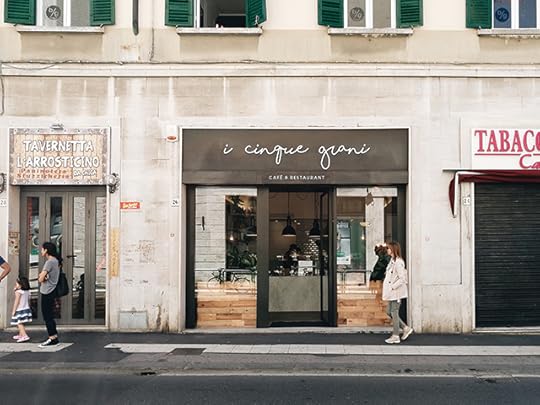
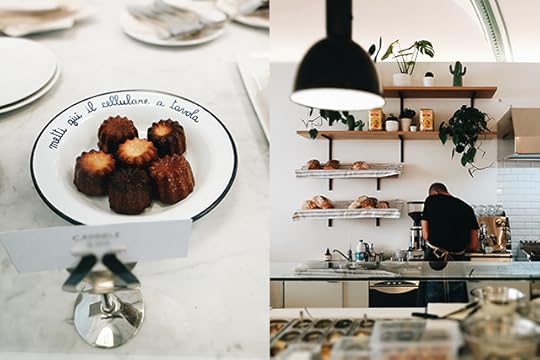
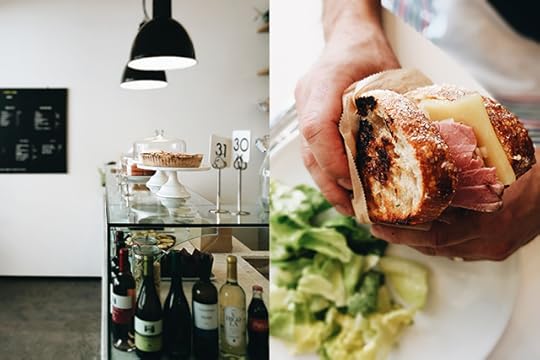
If you’re heading to Livorno, whether passing through to catch a ferry to Sardinia or on your way down the coast, it’s handy to know about this new cafe, I Cinque Grani, a bright, friendly slice of California run by a Californian-Livornese couple. With offerings like fresh juices, housemade sourdough bread and iced green tea, artisan beer and big salads, it’s a refreshing spot that even has a fun kids’ corner (and menu) to keep little ones relaxed and entertained.
Pop in for breakfast, a snack or lunch — they even have chia pudding and housemade American-style cakes like carrot cake and apple pie. If you’re an expat living in Italy, you’ll understand the frustration and longing when you get a craving for a proper Reuben sandwich knowing you won’t find it anywhere — until now. And it’s on their excellent California style sourdough, no less, which you can also buy by the loaf to take home (did I mention how excited I am about this?).
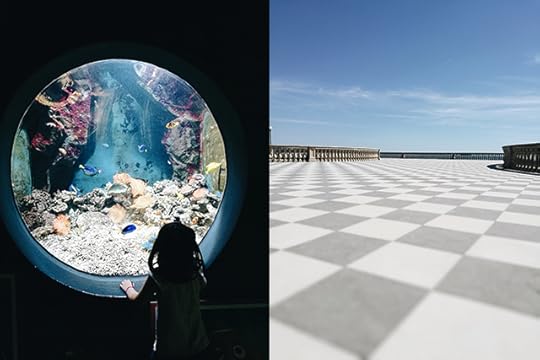
If you’re dragging little children around with you and they are hot and bored, you may like to know about Livorno’s aquarium, which sits next to the picturesque, checkerboard Terrazza Mascagni. The aquarium is small but the right size for preschoolers and young ones who find it has just the right amount of things to keep them entertained for an hour or so. It’s also cool inside, so a good place for a very hot day when the beach or pool is not an option. I’m told by the lovely folk at I Cinque Grani that the gelateria closest to the aquarium is excellent, too — Gelateria Caprilli (and they’re not the only ones; it’s named one of the top 100 artisan gelaterie in Italy — just note it’s closed on a Tuesday, which is the day I tried to go, sadly!).
Although we usually stay at the family flat, this time we booked a one-bedroom apartment at Il Bottaccio, which is near Venturina, an hour’s drive south of Livorno, 10 minutes from the seaside and walking distance to Calidario, the Etruscan hot springs, another one of our favourite places (the water is clear and like swimming in a river, always warm so it’s lovely, especially at night time).
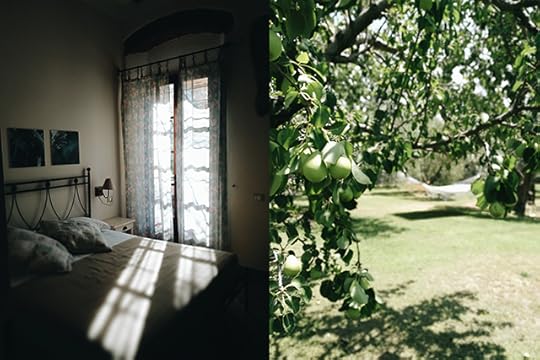
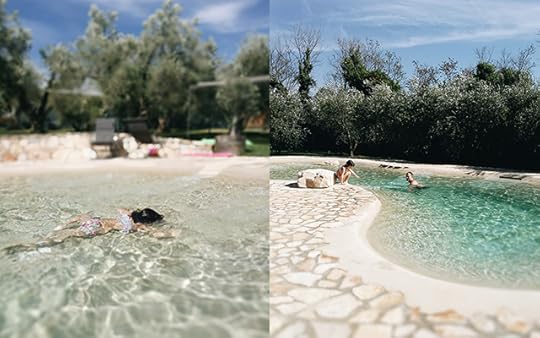
Il Bottaccio was a dream and as soon as we arrived we wished we had booked another night. A green oasis, the beautifully kept garden of olive and pear trees is scattered with large, loungy garden pillows where you might find a cat lounging, and under the olive trees there is also a well-placed hammock. The swimming pool, designed like a beach that gradually gets deeper, was our haven on a hot afternoon when even the thought of going to the beach itself was too much. The rooms are simple, tasteful and well-equipped (thank goodness) with air conditioning.
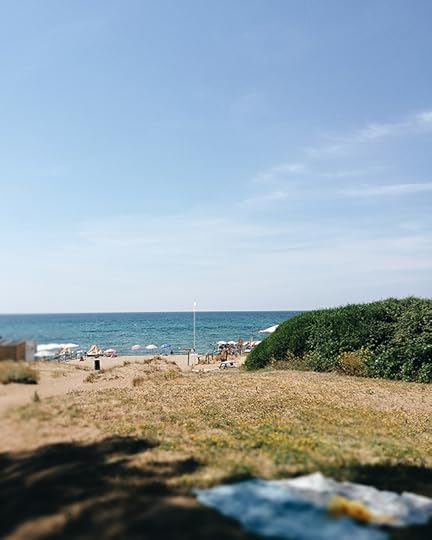
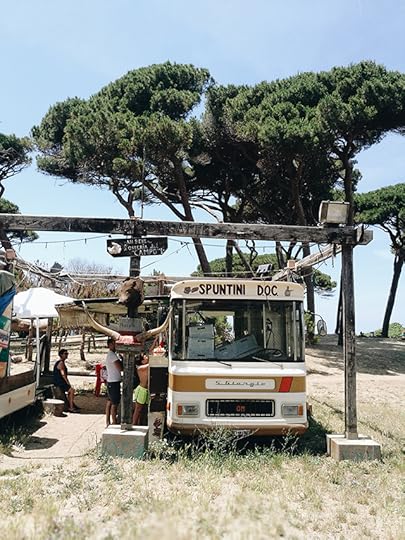
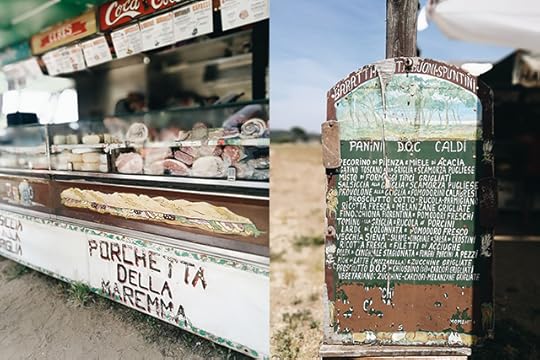
One of the reasons for booking Il Bottaccio was its proximity to my favourite beach Baratti, a lovely, relaxed bay not far from Populonia, a beautiful Etruscan village. From the car park, you walk through the forest of umbrella pines, which, in the long hot summer days can often be filled with picnicking families who come armed with tables, chairs, tablecloths, the works for long, drawn-out lunches.
And out in the field as you come out of the pine forest stands the retro panino van, il Casotto di Baratti, which has been serving up generous, warm panini filled with delights such as wild boar mortadella, pecorino pepato and tomato, or prosciutto crudo, Greek yogurt and grilled zucchini for the past ten years.
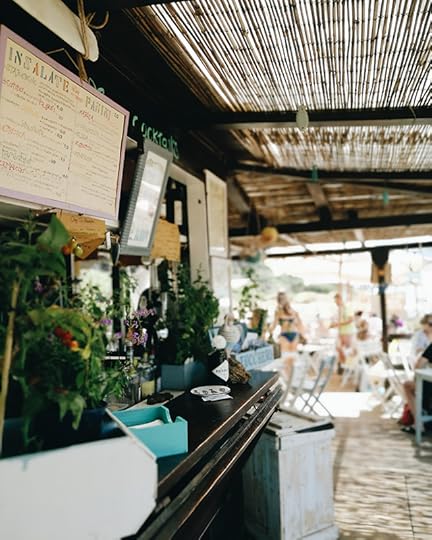
Baratti, unlike so many beaches on the Tuscan coast is mostly a free beach with a just couple of ‘bagni‘, establishments that offer a bar, showers and deck chairs and umbrellas that spread all the way to the water’s edge. Bagno Baratti, just to the right as you enter the beach via the main pathway, is a stylish wooden beach shack of an otherwise simple bar where you can get ice creams, coffee, panini, salads and cocktails all day — particularly nice in the evening for a spritz.
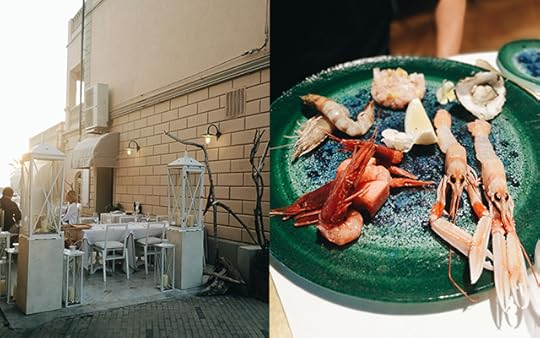
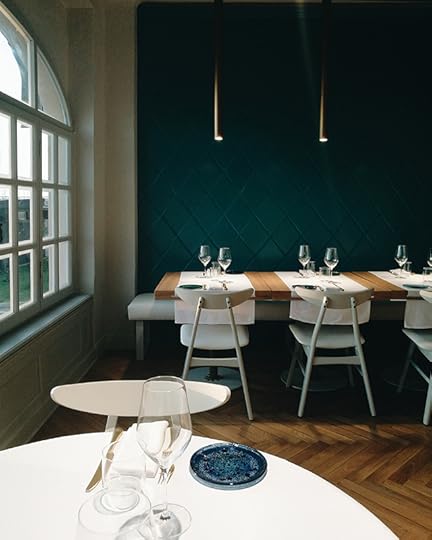
After a long, lazy day at the beach, a 25 minute drive away is San Vincenzo, a beach side town and marina where yachts collects and the train that runs down the length of the coast from Livorno towards Rome conveniently stops. There, in Piazza della Vittoria, you can find newly opened Papaveri e Mare, the seaside sibling of Papaveri e Papere in San Miniato — a long time favourite restaurant of ours from Marco’s hometown. It takes over the historic spot Gambero Rosso, which was run by Fulvio Pierangelini for thirty years and became one of Italy’s most famous restaurants (incidentally, his son, Fulvietto, runs the nearby and wonderful Il Bucaniere).
But even with big shoes to fill, the port-side terrace and intimate dining room under the helm of Teseo Geri and Fabrizio Marino exudes a relaxed and confident vibe, like they’ve been doing this forever (they sort of have). The menu is a celebration of trips and their influences, which are written next to the dishes — a plate of crudo (raw seafood, particularly prawns) inspired by Puglia, roasted pieces of octopus reminiscent of Greece, a delicate bouillabaisse with a pot of mixed pieces of fish from Corsica, which you can see from the view of the window of the restaurant on a clear day. Expect a bit of San Miniato by the sea once autumn arrives and San Miniato’s famous white truffles come into season. It’s good value for money considering the excellent quality of the seafood — for two people eating two courses each and sharing dessert and a bottle of wine, we spent 120 euro.
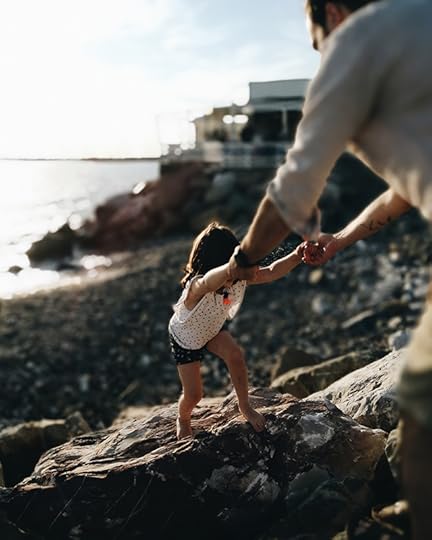
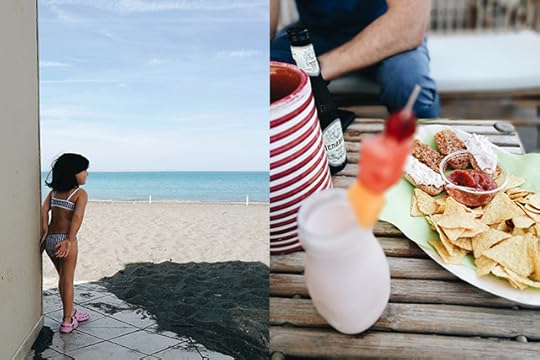
It’s an area that’s worth exploring further and for longer but it’s also just doable for a weekend getaway. The prospect of heading back to the heat of Florence after this seaside escape made us all feel a little flat so we made one more stop at the esplanade of the Marina di Cecina, where Marco’s family beach house is, to pop into our favourite juice bar, Mamasita, for a quick snack and refreshing cold drink. They make excellent (and very good value at 4 euro for a smoothie) fresh juices, smoothies and gelato with tropical flavours — our daughter requests a smoothie every time we visit.
More guides on the Tuscan coast for accommodation and eats:
My post from last summer on the Tuscan coast (including Castiglioncello, Bolgheri, Castagneto Carducci and Elba Island)
My food guide to Porto Ercole on Monte Argentario and the one for Gourmet Traveller
Giulia Scarpaleggia’s Small Guide to the Etruscan Coast
Girl in Florence’s Why you Should Visit the Etruscan Coast
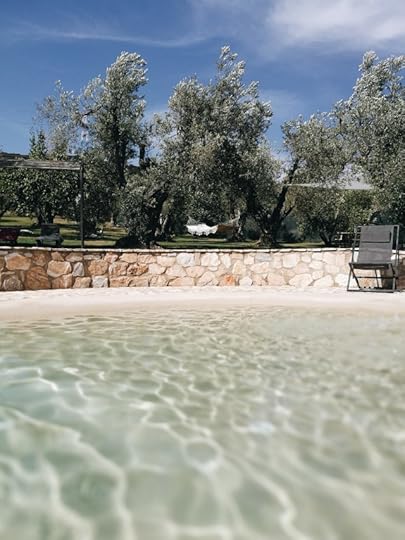
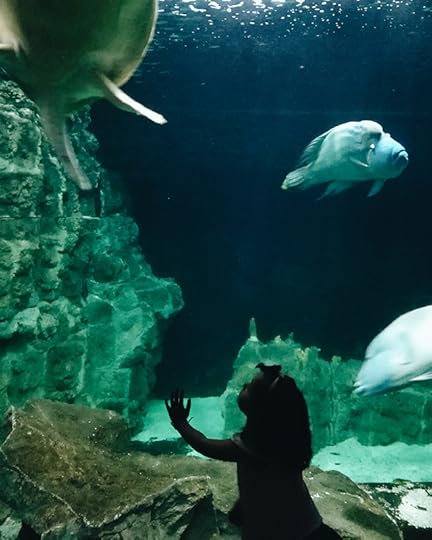
June 11, 2017
Food and family — an interview for Wee Magazine
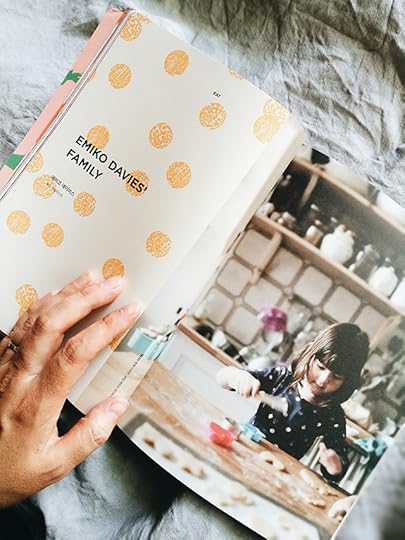
Last month I received a beautiful magazine in the mail. It had tactile rag paper, colourful and quirky illustrations and was filled with stories about families and their food habits, children’s food drawings, what people feed their families around the world and tales of good and real food — all in Korean! I was honoured to be interviewed in a story about what goes on my family’s table and how we involve our daughter in learning good food habits.
I have been asked by friends if I had a version translated in English and luckily I did the original interview in English with Wee Magazine editor, Gina. I’m happy to be able to share it with you here, along with some photographs and a list of recipes that I think kids in particular would have a good time cooking — they are tried and true, we love to cook these at home together.
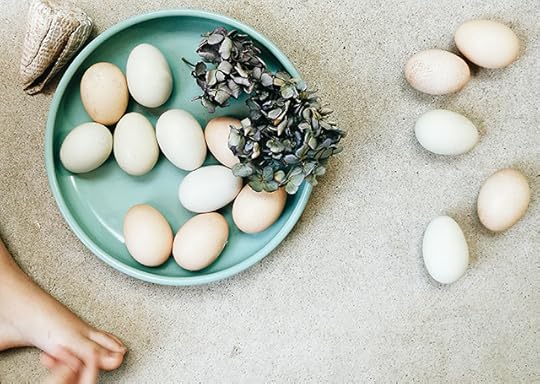
Gina: We always eat. To sustain our lives, we always eat and have to eat. With its long history, however, eating doesn’t mean just only eating. It means the way we cook the food, we choose the ingredients, reflect the situation to menu and, most of all, the way we get together and sit around. Right, eating means getting together and sharing everything each other, nowadays. In modern times, some family has lost this kind of value because of being stuck in busy schedules. That’s why I found you and want to ask you about you and your family on this matter. What family members do you have in your family?
Emiko: It’s just me, my husband and our daughter, who is now 4 years old.
Gina: What time do you usually eat together in a day? And how often?
Emiko: My husband works in a Michelin-starred restaurant as a sommelier, so we have a really unusual family schedule. He begins work in the afternoon for the evening shift at the restaurant and because he gets home in the middle of the night, he sleeps in late, so our main meal together, every day, is lunch – it’s almost always at home and something simple. For breakfast and dinner it’s usually just me and my daughter, so I always make sure the two of us eat together for those meals too.
Gina: Are there any table manners that your kids should keep? What are they? And why do you think children should learn table manners?
Emiko: I don’t try to make her learn any table manners specifically, I’d just like for her learn naturally, by example. She has always spent a lot of time with adults — eating out at restaurants and cafes with me, or even just being at home, and seeing how we behave and she has already figured it out!
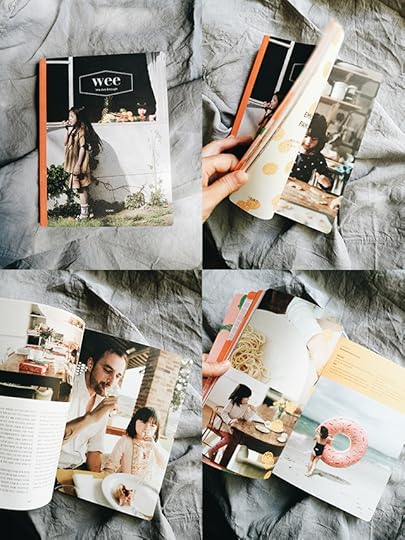
Gina: What menu has been the most popular on your table, so far?
Emiko: My daughter is a fussy eater and loves very simply prepared dishes – the less done to it the better! Her favourite things at home are boiled or fried eggs or rice with dried seaweed. Miso soup. Raw vegetable sticks or crunchy apples (but they have to be whole). And pizza margherita, with just tomato sauce and mozzarella, is always a hit, sometimes we make it at home together.
Gina: Frankly speaking, many people are so busy that they can’t have enough time to eat with their family. It is a reality that we face. What do you think about this matter?
Emiko: In Italy, it’s still generally the case that families eat together. It’s one of the reasons why children have a much later bed time here, but it is also one of the things that I appreciate about living here. I think it’s really important to take time, not only to eat together, but to allow meal time to be relaxed, not rushed. Maybe put a tablecloth down, pour a glass of wine (for the adults anyway!) and serve different courses, and also involve the children so they’re not just jumping up and running away to play, but so that they are part of the experience too. The family table then is a comfortable, comforting place to talk to each other, to share and create memories.
Gina: What ingredients are your child’s favorites? And in an opposite case, what ingredients are the ones she hates?
Emiko: My daughter loves almost any kind of fruit, as well as milk, eggs and yogurt. Vegetables are more difficult to get her to eat but she loves crunchy raw vegetables like carrots and cucumber. And she could live off gelato (which is one of the reasons I have recently bought a gelato machine!). At the moment she doesn’t like chocolate or cakes, which is great actually, but I suspect once she actually tries them she might discover a love for them!
Gina: What usually do you cook for anniversary in your house?
Emiko: When there is a special occasion, we like to cook bistecca, which is a very large, thick Florentine T-bone steak. It’s grilled rare, and we usually have it with spinach sauteed with garlic and chilli and some simply cooked chickpeas or cannellini beans.
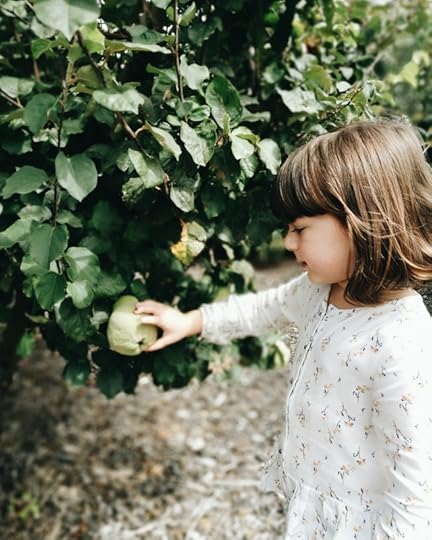
Gina: I wonder if your husband does cook as much as you. How often does he do for your family? And what was the best menu that he did?
Emiko: My husband is a great cook and he loves cooking – for him, it’s a way to relax when he’s not at work. He will cook most days, usually lunch when he’s still at home and before he goes to work. He loves cooking meat or fish best and likes experimenting too. He cooks mackerel in a really wonderful way that I love, salting it first so that it becomes slightly firm and very flavourful, then cooking it in a pan over baking paper so that the skin doesn’t stick.
Gina: Many researchers are trying to reveal the truth about the food, such as ‘Milk is not good for health’ (just as an example). For these information, what kind of activities do you do? Or where do you usually get this information?
Emiko: To be honest, I try to stay away from these kind of things. I don’t think demonising one type of food group or ingredient is ever going to be the answer to “healthy food”. And everyone is different, some people can’t tolerate dairy or wheat, so have to adjust their diets. I like to try to keep meals balanced – a bit of everything and not too much of one thing, a bit of common sense, too. My husband has to limit wheat intake so as a family we don’t eat much bread or pasta, only occasionally. My daughter loves dairy foods and, as she is such a picky eater, it’s one of her main sources of protein and calcium.
Gina: Finally, could you share a recipe that you’d love to cook for your family?
Emiko: Rosticciana (or grilled pork ribs) is one of those dishes that you would order in a trattoria or have at a gathering at home when there are plenty of people to share it with. In a trattoria, ‘grigliata mista‘ (literally ‘mixed grill’) is a wonderful, large metal platter of rosticciana, Tuscan sausages, grilled chicken and perhaps some pork on skewers or rare grilled steak. They go well with traditional side dishes such as roast potatoes, stewed cannellini beans or something green, like a simple green salad. It’s a great dish to make on the barbeque too, now that it’s grilling season when you have a lot of people to feed!
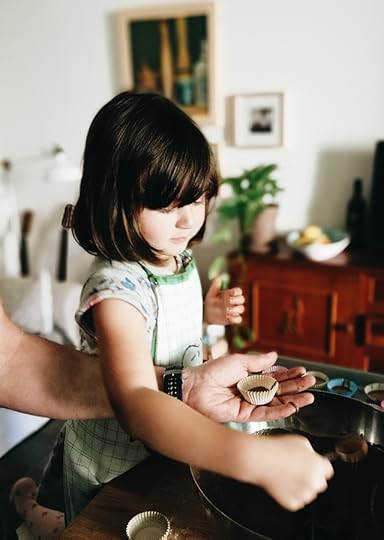
Get your children cooking in the kitchen with some of these:
Befanini, soft Tuscan cookies.
Focaccia Pugliese, a soft, easy dough studded with cherry tomatoes
Homemade pizza is always a hit in our family. This one is for pizza with tomato sauce, mascarpone and speck but you can top it however you like best.
Broad bean pesto. Little toddlers are very good at podding peas and beans with their little hands. Put them to work, they’ll love helping pod beans for this pesto.
Homemade ‘farfalle’ or bowtie pasta are really fun for kids to make.
Classic crostata or tart with apricot jam — if your kids like playing with playdough they might like pastry too where they can help roll out the dough and make the lattice top. Small versions made in a muffin tin are great too.
Easiest butterless, eggless chocolate cake — my daughter loves to mix batter for cakes and cupcakes and this is a really simple one to whip up, especially because it calls for only a few ingredients!
Tiramisu — I find that anything done in a repetitive production line (dip, layer, blob, dip, layer, blob…) is something that kids like to do too! Then of course you get to lick the bowl. To make it child friendly, use decaf coffee.
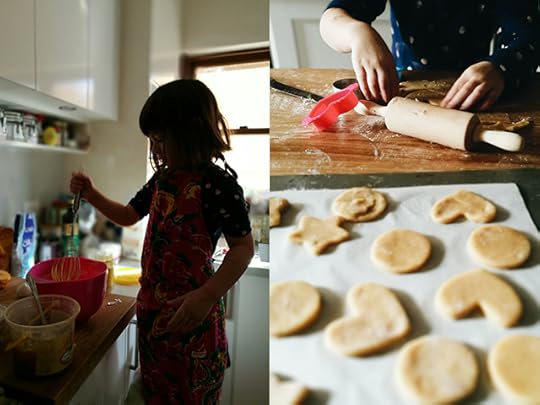
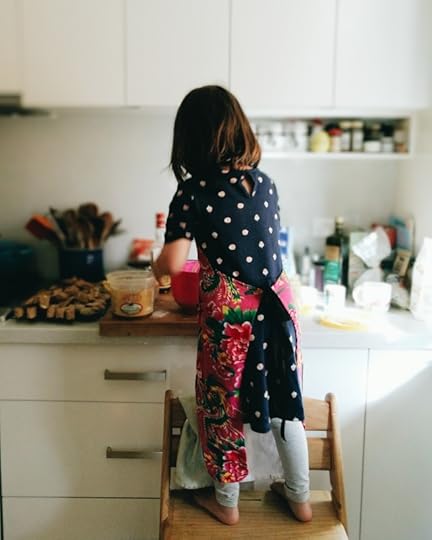
May 30, 2017
Workshop announcement: The Puglia Encounter

I’m so very excited to announce my involvement in a workshop in October this year in, what is for me, the most authentic and heart-racing region of Italy — Puglia. I’ve never eaten so well as in Puglia, or been so entranced by a place’s open spaces, its ancient olive trees, its cheap produce markets and unusual fruit and vegetables, its elegant baroque and white-washed towns, its turquoise water and deep red earth. Combine that intense beauty with a place like Masseria Potenti (the place where Australian designer Collette Dinnigan escaped to with her family for a luscious delicious magazine shoot) and I am in absolute heaven.
Now add in a field trip to nearby Grottaglie, a city known for its artisan ceramics – just take a look at Carla Coulson’s swoon-worthy photo essay on the town — and roaming through the fields of Manduria (Puglia’s primitivo wine region) to collect wild herbs and flowers, then harvesting vegetables from the Masseria’s self-sustainable kitchen garden and I know this is about as special as a trip can get.



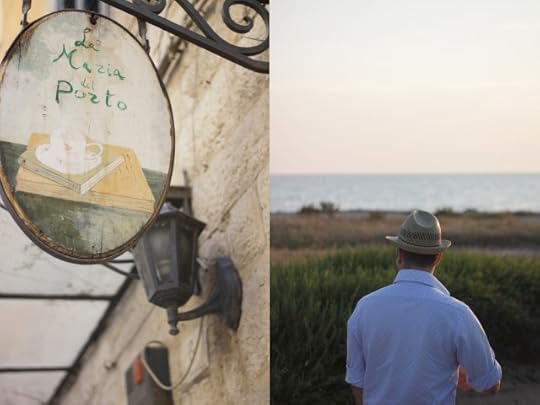

Together with Saghar Setareh and Alice Adams of Rome’s Latteria Studio, we will spent two and half days at Masseria Potenti, cooking, styling, eating and creating beautiful content for your blogs, portfolios, social media or even just for the memory and experience of the trip.
And in fact, once in Puglia for this workshop, you will want to extend your trip to visit some other beautiful places. This garden courtyard in Salento is where I had one of my top meals anywhere, ever. Actually so was this one in Andria, in northern Puglia. And hopping from butcher’s shop to butcher’s shop in Cisternino for a freshly grilled meal to was incredible. Then there was the visit to the underground olive oil mills near Gallipoli. The NY Times also agrees that low season to be the best time to be in Puglia, particularly for the food. Read on for the full programme and details.


The Puglia Encounter – Autumn Edition
Food, lifestyle and photography in Italy’s Deep South
Where: La Masseria Potenti (above) near Manduria, Puglia, about 15km from the turquoise Ionian sea and one hour from Brindisi (the closest airport). The white-washed masseria (a traditional Pugliese farmhouse), which dates back to the 1300s, is an oasis in the rugged, “wild west” of Puglia, set amongst grain fields, ancient olive groves and Primitivo vineyards. A boutique agriturismo and self-sustainable farm of 130 hectares, the masseria was brought to life by Maria Grazia Di Lauro and her husband Paolo, whose dream was to transmit their love for their native land to their children and friends. It’s a special place that will inspire every one of your senses.
Web | Instagram
What: The experience will include two and a half days of cooking, photography and styling sessions with your hosts, who will share their experience with you, as well as an excursion to nearby Grottaglie to discover the artisan ceramics and local cheesemakers. We will take a wander through nearby fields and pick vegetables out of the garden to prepare meals and set the table. There will be delicious, traditional meals prepared by the cooks of the Masseria – and plenty of time to relax and enjoy the Masseria in between.
When: 26-29 October 2017.
Who: This is ideal for anyone who is interested in travel, food and photography, creatives, food writers, travel writers, bloggers wanting to learn more or fill a portfolio full of inspiring images and stories and anyone who simply wants to spend a few wonderful days with like-minded people exploring and enjoying this incredibly authentic part of Southern Italy. There will be a maximum 12 people.
Your hosts:
Emiko Davies is an Australian food writer based in Florence, the author of two cookbooks, Florentine and Acquacotta. She writes recipes on regional Italian cuisine for her blog and her Food52 column and has written food and travel guides for publications such as The Guardian, Saveur, Jamie Magazine and Gourmet Traveller. She loves to cook simple, unfussy food, tell stories and, when possible, to take photographs with good old fashioned film. Web | Instagram
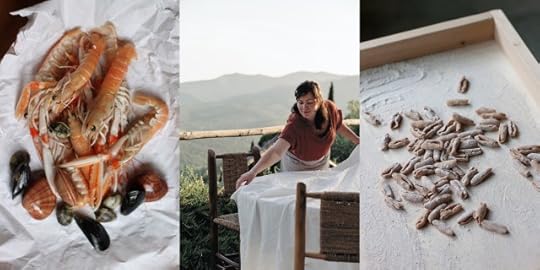
Saghar Setareh is an Iranian food photographer and blogger based in Rome for the past decade, where she discovered her love for the culinary arts of all forms. She publishes photography and stories about Persian and Italian recipes on her award-winning blog Lab Noon, and collaborates with restaurants, chefs and food brands regarding their digital communication, especially food photography. She also teaches cooking, styling and photography workshops. Web | Instagram

Alice Adams is an Australian cook and food stylist based in Rome. She works with local and international photographers and in 2015 created Latteria Studio as a food photography studio, a home for her ceramics and linen collection, and as a creative space for cooking lessons and workshops. Happiest in a market of any kind, she loves seeking out the special places to find the ingredients and props that help tell meaningful food stories. Web | Instagram
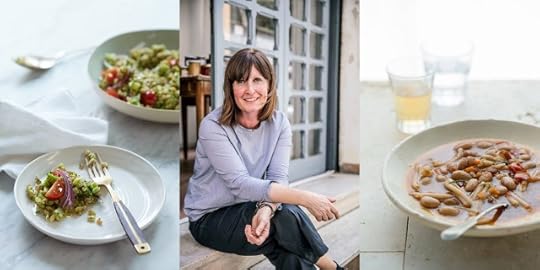
The workshop is brought to you by Talea, the brainchild of Chiara Tommasino and Valentina Guttuso, an event design agency that creates nonconventional, exclusive experiences in alluring locations. Named after the Italian word for a plant cutting, the duo bring life to new ideas for projects and events, organising every last detail, from the creative beginnings to the styling and setting. Instagram

How much: 1850 euro per person
Included in the price:
Three nights accommodation at the beautiful Masseria Potenti. Accommodation is in single occupancy rooms in the Masseria’s apartments, with shared bathroom and living spaces. (You’re welcome to enquire about double occupancy rooms if you would like to come with a friend or partner, and suite rates if you would like additional space)
All meals, refreshments and snacks.
All excursions, including foraging and visit to the ceramics workshops in the nearby town of Grottaglie.
Two and a half days of workshops that will cover cooking and food writing, food and lifestyle photography and styling (see below for the programme).
Not included: Flights or airport transfers, the latter of which can be arranged by the Masseria (Brindisi is the closest airport).
To book: To book please email with “Attention to Chiara” in subject line at info@masseriapotenti.com. A deposit of 50% is required to register for the workshop with final payment due by 15 October, 2017. If you have any allergies or dietary requirements please remember to let us know when booking.


Suggested programme*
Thursday 26 October
6pm – arrival, welcome aperitivo. Introduction and mingling
Friday 27 October
9 am – breakfast
10 am – coffee and morning tea with an introduction to the photography session by Sagar, followed by cooking session, styling and photography in three groups with Emiko, Alice and Sagar.
1 pm – lunch and time to relax
3 pm – field trip to Grottaglie, the city of ceramics
8 pm – dinner
Saturday 28 October
9 am – breakfast
10 am – a wander through the masseria grounds and surrounds to harvest local produce, herbs and flowers
11 am – setting a scene and making a meal with local produce
1 pm – lunch and time to relax
3 pm – social media, recipe writing, blogging, visual voice talk followed by lightroom editing
5 pm – fresh pasta making with Nonna Esther
8pm – dinner with Nonna’s fresh pasta
Sunday 29 October
10am – brunch and farewell
*The programme may change or have slight variations due to weather or availability.
What to pack: Bring a manual camera, a notebook and an appetite. The weather in Puglia during autumn is mild, it usually hovers around 20ºC/68ºF during the day and 15ºC/59ºF at night.
Cancellations: Due to logistics, there will be no refunds on cancellations. However, we can accept a replacement for your spot. We recommend you have travel insurance in the event of any unforeseen events.


May 25, 2017
Rose petal and ricotta tartlets

When a friend tells you she has wild roses blooming everywhere, it’s not hard to imagine where the conversation headed to next… to turning them into rose petal jam, of course.
My friend Simona Quirini and her family run the beautiful Canto del Maggio, a B&B, restaurant and garden, about one hour’s drive from Florence. We arrived to catch Simona with a wooden crate in her hands, already half full of blush pink flower heads, small and as fragrant as honey.
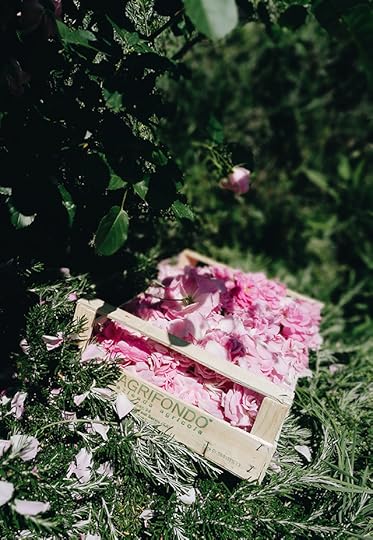

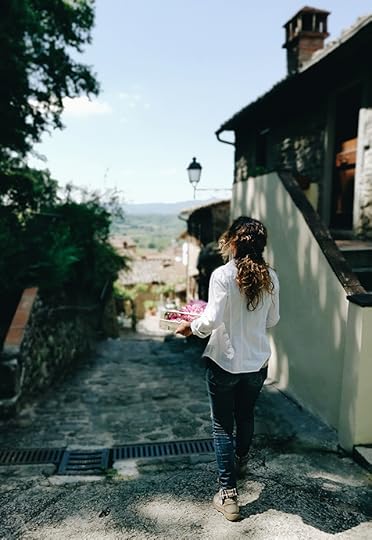
It wasn’t just roses that were bursting out of their bushes with colour and fragrance. In fact, every time I go to Canto del Maggio, I notice how lush the property is with fruit, flowers and plants, and every season there are bounties to be collected. The first time I was there I noticed the myrtle bushes and heirloom fruit trees — little tiny, red pears and apples. The garden was full of summer produce and I stole green-skinned figs harbouring raspberry-red flesh off the trees. The next time I went, we picked ripe olives off the trees around the pool and took them down to the local frantoio, olive oil mill, to press the bright green oil out of them. I also came home with buckets of corbezzoli, or Irish strawberries, to make jam. This spring, I noticed the hedge rows of flowering wild strawberries and this last visit we picked the berries off them for an afternoon snack.
With the help of my daughter (who was slightly more interested in playing with Simona’s new puppy), we filled a crateful of roses and picked the petals delicately off and into bowls. We were using the rose petal jam recipe and the technique I learned between two wonderful sources — Pellegrino Artusi’s 1891 cookbook (this pastry recipe below is also inspired by it) and the Armenian monks on Venice’s Isola di San Lazzaro Island where I worked for two autumns. The secret, other than having beautiful, small and fragrant roses to begin with, is in massaging the petals with a bit of the sugar and the lemon juice until almost a pulp to release the essential oils.


Then we divided the mixture into two and experimented — one batch with white sugar, as per the normal recipe, and the other batch with raw sugar. The one made with white sugar kept a decidedly prettier colour — a deep, dark pink — and fragrance. The one with raw sugar turned brown and the slightly caramel flavour of the raw sugar overpowered the delicate rose. Possibly, we thought, the sugar could be reduced a bit in the jam recipe to a more balanced syrup ratio. For next year’s jam.
While I’m saving one of the jars we made for simply enjoying as is on bread with some very good, unsalted butter, with the other I made these rose petal and ricotta tartlets. They are loosely based on the classic Roman ricotta crostata which is, by tradition, made with a slick of sour cherry jam (this was a really fun recipe and shoot that I did in Rome with photographer Lauren Bamford), made here into small tarts with a reduction in sugar (across both the filling and the pastry) because I find this rose petal jam sweeter than sour cherry jam, which has a bit of natural tartness to it.
Simona also got sent me home with an extra bag full of rose petals, which I am still air drying. They look rather lovely scattered over the top of these fragrant, special tarts too.
If you’d like an excuse to visit Canto del Maggio this summer, I will be doing an evening event there together with one of my most admired cookbook writers, Tessa Kiros. We will be talking about travels, food and cookbooks amongst the olive trees and there’ll be an al fresco buffet of dishes from our cookbooks to taste. Save the date — July 6, 2017; 30 euro includes buffet and wine, bookings can be made directly through Simona. More events and information here.
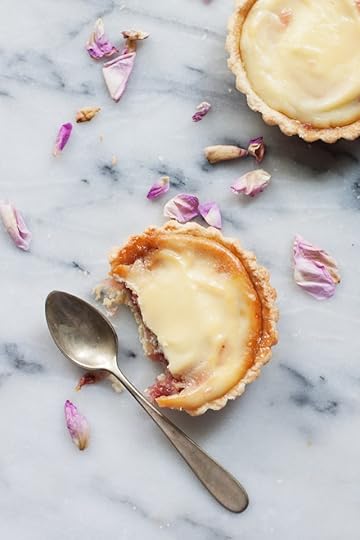
Crostatine di rose e ricotta
Rose petal and ricotta tartlets
For the pastry:
250 grams of flour
125 grams of cold butter, chopped
50 grams sugar
1 whole egg
1 egg yolk
For the filling:
200 grams of this rose petal jam
150 grams of ricotta
1 egg
1 tablespoon of sugar
1 tablespoon of rose water or a squeeze of lemon juice
For the pastry, if making it by hand, rub the flour and butter together until you can no longer feel big pieces of butter. Add the rest of the ingredients and combine until it comes together in a firm ball. Cover and let rest in the fridge 30 minutes.
Roll the pastry out to about 3-4mm in height (about 1/10 inch) and fill 6 small tartlet cases with to cover evenly with the pastry. Poke holes all over the base with the tines of a fork. Set aside (if it’s a warm day, keep them somewhere cool like the fridge).
For the filling, combine the ricotta, egg, sugar and rose water or lemon juice until smooth.
Spoon the jam over the bottom of the tart bases to cover by about 1cm. Then spoon the filling over the top and smooth over.
Bake in the oven at 180C (350F) for about 20-25 minutes or until the pastry crust is deep golden and the top starting to colour. Let cool completely before serving.

May 19, 2017
Acquacotta giveaway + new workshops and events!
I have been busy preparing and organising some new, exciting things, from cooking classes to a workshop in beautiful Puglia in southern Italy, even a little online shop (coming soon)! I’ve decided to put it all in a blog post to have in one place. And to celebrate, I’ve also got some copies of my new cookbook, Acquacotta, to giveaway to five lucky (Australia-based) readers! (Would you like a sneak peek? There is a collection of favourite recipes here on Cooked). Read on for more.

Events:
Rome, Saturday 17 June, 2017 — Acquacotta Cooking Class
Join me at the Latteria Studio, a bright, wonderful, intimate cooking space in Trastevere, where we will prepare and cook together some favourite summery, Maremman recipes from my new cookbook (such as the handrolled strozzapreti below, a bright salad from Giglio Island, seafood stew and melon granita) around a table like old friends. Lunch (our masterpieces) will follow. The class and lunch cost 100 euro ($140 Australian dollars). Very limited spots — book here.
Florence, Thursday 22 June, 2017 — Florentine & Acquacotta Florence launch
Betty Soldi and Matteo Perduca, the charming and dynamic duo behind Soprarno Suites, Adastra, And Company and Sottarno, a charming new cafe in Florence’s Santo Spirito area, are hosting an author talk with nibbles inspired by my cookbooks, Florentine & Acquacotta. The evening will start with a glass of wine and involve a conversation with me & Matteo about Florentine and Tuscan food traditions and end with mingling and eating. More information for booking coming soon.
Tuscany, 6 July, 2017 — A summer evening with Tessa Kiros & Emiko Davies
Join me and my cookbook hero, Tessa Kiros, for an intimate and casual chat about cookbook writing, travel and the food it leads us to, in the magical garden of Canto Del Maggio, in Tuscany’s Valdarno valley (between Florence and Arezzo). A buffet around the pool, with drinks, will feature recipes out of our latest cookbooks. Tickets 30 euro. For bookings, contact Simona Quirini, +39 339 26416 72 or simoqui@me.com
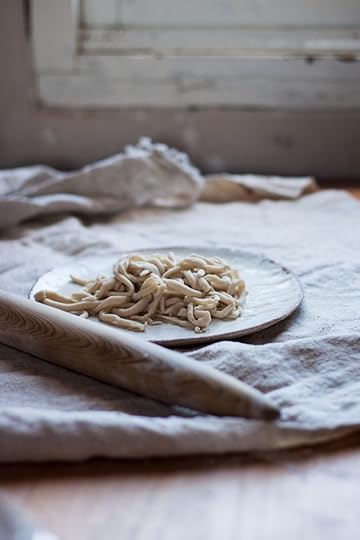

Workshops:
I’m very excited to be working on several wonderful projects coming up this year with some very inspiring, creative colleagues — more details to follow very soon with their own dedicated blog posts, but if you are thinking of being in Florence or Puglia in October 2017 and want to eat, explore, create, and be inspired with like-minded people, keep an eye out here for more details by the end of the month!
Pictured throughout this post are images from an Acquacotta inspired one-day workshop I did with the amazing Sophie Hansen of Local is Lovely in her hometown, Orange in country New South Wales. We were based at The Old Convent, run by Josie Chapman, where we cooked, styled, photographed and talked about how to create stories, recipes and how to connect on social media channels with an enthusiastic group of 15 people.
We started with an introduction over coffee, visited a beautiful fruit orchard where we had morning tea with treats from my cookbook under the dappled light of fig trees and picked apples, then we had a delicious lunch prepared by Josie (wow, I could eat her food all day every day), and afterwards we dove into some recipe demonstrations, shooting and styling, in smaller groups. There was an hour at the end of the workshop for another coffee, some homemade biscotti made from my cookbook and a Q&A.
Keep your eyes peeled on my events page for more things like this! And Sophie’s excellent line up of workshops can be found here.


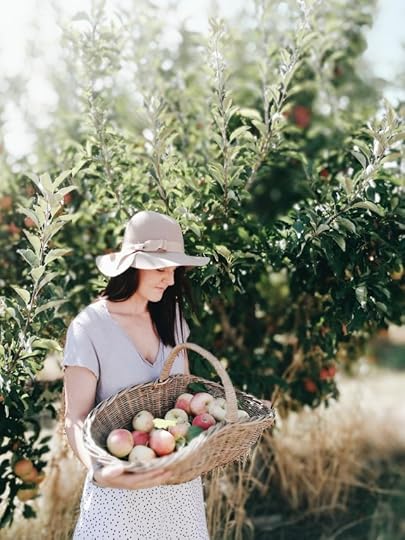



Now, to the exciting part!
Giveaway:
So much love went into the making of my latest cookbook, Acquacotta, which tells the stories behind the cuisine of an under-discovered part of southern Tuscany, a corner of the wild and rugged Maremma (here is a post on the “behind the scenes” of the making of it).
I’d love to share some of this love by giving away five copies of my cookbook to some lucky readers (sorry but this is only open to Australian residents at this time!). All you have to do is leave a comment on this blog post saying where in the world you’d love to be transported to just to eat the food for a day!
You have until midnight, June 3rd to enter, I will announce winners here and on instagram on June 5th, 2017!
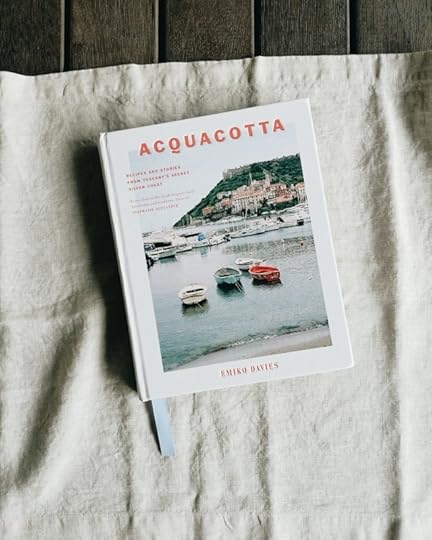
May 15, 2017
A family photo shoot with Birgitte Brondsted

I’m so excited to share the photographs from a recent family portrait session. It’s rare that I post photographs of myself. I prefer to hide behind the other side of the lens, I feel more comfortable photographing other people. But I realise, as I make connections with people online, on instagram, through my cookbooks and blog, that it’s nice to put a face to the name and the voice.
And I want to say hello.
I’ve had the luck of having many talented, dear photographer friends take photos of me and my family, including my sister. For this recent shoot, I reached out to a fellow Florence-based expat, Danish photographer Birgitte Brondsted, whose work I have always admired.
Although the aim of the shoot was to have a few photographs I could use to update my blog and social media with, I wanted to include my family in these photographs because they are such a large part of my work. Marco is the ‘experimental’ cook, the one trying to cure his own bottarga and who loves all the technical details behind the sizzle of a steak or the perfect rise when baking bread. It may be because of all the years of working in fine dining restaurants or all the hours he spends watching Chef Steps. Marco, although behind the scenes, has done so much to inspire and support and help me cook, while also teaching me about wine and keeping my glass topped up (he is a sommelier after all). Many of the dishes photographed in my cookbooks were ones he offered to cook. But well before I began writing cookbooks, though, he has always been there, behind the scenes.
And now, even our daughter is a huge help in the kitchen too, particularly when some kind of dough is concerned. She’s been by my side since day one of my cookbook writing career, literally, and has made her mark throughout both my cookbooks!


We started with some photographs in our tiny kitchen (which you can read a bit more about on Wall Street Journal’s In My Kitchen interview), renovated with an equally tiny budget but a lot of love, doing something we would usually cook together — pizza, a basic recipe that I have used in both my cookbooks, Florentine and Acquacotta. Then we took our pizzette down to the abandoned and overgrown olive grove that we live next to — along with a neighbour’s Jack Russell, Nutella, who lives in our house during the day while the neighbour is at work — for an impromptu picnic.
I loved that we were able to be at home, offering a peek at where we live in the hills of Florence — a humble apartment in a beautiful gem of a neighbourhood, Settignano.

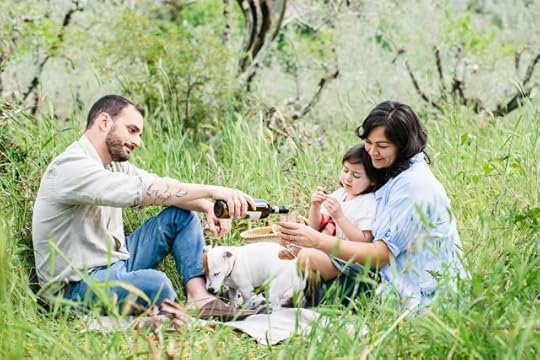
Photographs by Birgitte Brondsted in Florence.
Emiko Davies's Blog
- Emiko Davies's profile
- 13 followers



